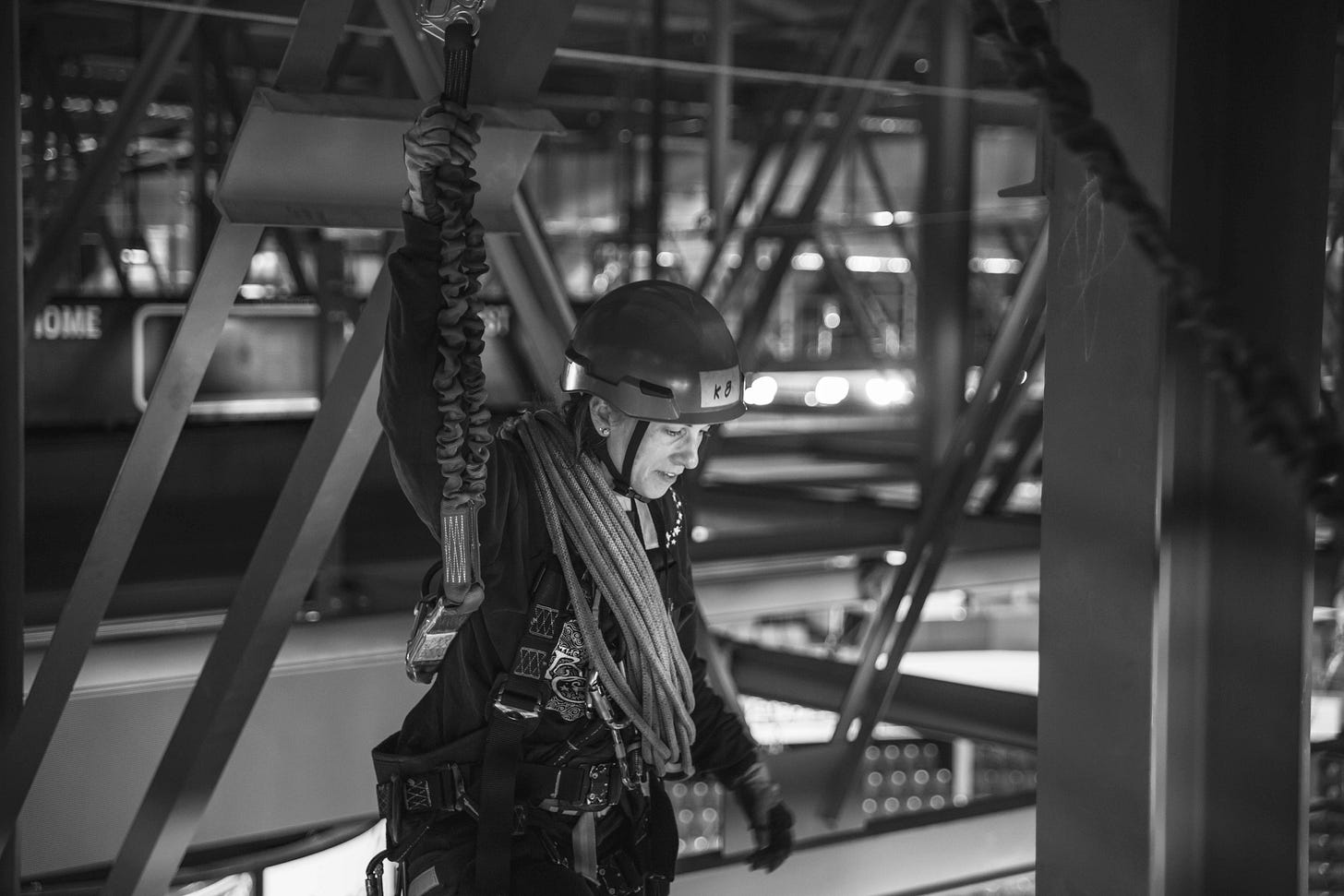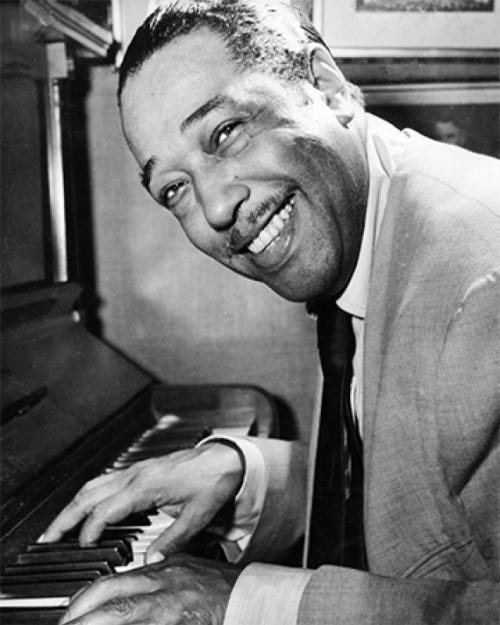Stories from the Edge of Music #60: BEHIND THE SCENES: High above the stage, a rigger at work (part one of two)
And more Duke Ellington tales
Flashback 55 years: The second part of a Canadian musician’s experiences playing with the Duke Ellington orchestra.
And behind the dreaded paywall, more personal stuff: how this writer gets along with little kids — and what he’s up to this summer.
++++++++++++++++++++++++++++++++++++

You won’t see Kayt Lucas at work. She’s building the show you’re going to see, and she’s tearing it down while you’re back home ready for bed
Kate Lucas is my neighbour and also a good friend. She is also one of the invisible people who make the concerts you see and hear seem both spectacular and special.
She’s a rigger, and I asked her to tell you what she does and how she does it.
Here’s the first part of her story. More next week!
Not everyone knows what a rigger is — can you explain what you do?
Concert rigging involves suspending technical and set elements over a stage, and even over the audience. When a show’s on tour, productions expect everything to hang in the same place in every venue, so we build in the difference between the top of the theatrical space and the roof.
Everyday rigging consists of climbing, rope technique, lift operation, math, preparation and planning, a lot of gear and a lot of yelling — even though we mostly use radios.
What do you need to do this job properly?
A very specific set of skills: little-to-no fear of heights, physical strength, climbing skills, and coordination. Rigging’s a team effort; it’s important to be responsible, accountable, and prove to your colleagues that you’re dependable and a team-player.
On the clock, we watch how production elements are loaded, double-check each other’s work, and welcome inspection — if not out of curiosity, then for peace of mind.
Off the clock, we’ll sometimes call one another just to talk through rigging problems. We can’t get enough of this stuff!
What does a typical day look like for you?
We start building for the concert early in the morning; we’re there even before the trucks start unloading. On shift, we use personal safety systems to allow us to get to where we need to be to do our work.
After that, we then use a combination of recreational-style and industrial hardware and software (ropes, pulleys) to pull steel cables and chains to the roof. The cables create the geometry to hang everything in the perfect place, while the chains are for hoist motors that climb the chains and bring the stage elements upwards.
Then, at night, after a concert, the opposite happens: rigging has to wait until all the ground elements are packed up. We are the last people to finish in the stage space, and our cases are the last to get loaded back onto the trucks.
What sort of income can riggers expect to make?
Sometimes we’re hired for specific tours, or specific venues, sometimes by artists’ own companies and sometimes by independent contractors.
The salaries we get paid vary wildly. At the upper end, a career rigger’s take-home is similar to that of a professional engineer. At the bottom end, there are barely-more-than-minimum-wage jobs when the venues have low ceilings with pre-installed attachment points.
Corporate tech companies have taken over most of these low-end jobs and driven the pay rates way down. This infuriates me — it allows people without proper experience to call themselves riggers.
When you’re working on a show with touring artists, do they bring their own crews?
Large touring productions typically bring their own head rigger, along with an assistant and possibly a few dedicated tour riggers. They work with the local crews and there’s usually a good level of co-operation.
Is the job dangerous? How do you keep it safe?
This job is inherently dangerous. Working at heights and handling tools over people’s heads always has risks. When I began this career, there were fewer regulations, more free-handling of loose tools and free climbing without ropes.
I began climbing mountains in Alberta in the early ’90s, and since then the gear for both recreational and professional climbers has developed tremendously.
On a daily basis, I carry as much as 25 lb more safety gear than I did when I started. We also have a routine of safety checks, and for large productions, medics are always on-site. Standardization has also helped lower the risks.
I love it that things are safer than they used to be.
Have you ever had any close calls?
It really affects me when things go wrong. Once I dropped something — no one got hurt, and no damage was done — and I was squirming internally for days afterwards.
Rigging involves real risks, and part of the job is learning to accept them without becoming numb to them.
Next week, Part 2: Kayt’s personal story and her takes on the most memorable shows she’s worked on.
++++++++++++++++++++++++++++++++++++++++++++++
FRED STONE, A CANADIAN IN ELLINGTON’S BAND IN THE LATE ‘60s, RECALLS MORE STORIES OF A LEGEND ON THE ROAD
Armed with a plane ticket to Chicago, Fred Stone realized the Ellington organization was, shall we say, somewhat “loose.” He had not been told where his first gig with the band was taking place. Two calls, one to the Chicago daily newspaper and another to the Duke Ellington Society’s listed phone number, got him the information he needed.
As the only person in the band who didn’t know the repertoire and the arrangements by heart, he spent a significant part of each song searching for the trumpet parts in the thick collection of charts under each musician’s seat.
When I was interviewing him for the piece I wrote about Stone in 1970, he told me: “The way most of our gigs started was when the rhythm section came out and played a couple of numbers, just so the rest of the band could get it together to come onto the bandstand.
“One trombone player walked on, then a couple of the sax guys and then finally most of the guys are there and the band would play the first tune.
“But,” he continued, “Duke wasn’t anywhere near the bandstand yet. Where was he? Nobody knew — was he sleeping, sitting with a woman somewhere, writing, backstage in the dressing room?”
Ellington called a recording session in Milan to play a piece Stone had written in the mid-’60s for Ron Collier’s group in Toronto. “I just gave him the nucleus of it — I wanted him to add his personal touch. He made a number of suggestions, all the time asking whether I liked what he was doing.
“What he added was a sort of oriental touch to it, and when the session was over he told me ‘That’s our new Afro-Asian Suite.’ ‘Oh,’ I said, ‘is there one (already)?’”
Ellington replied: “There is now. And it’s going to be on the next album and furthermore it’ll be on the show every night.”
+++++++++++++++
The Ellington style: disarmingly casual
“The Ellington band is the only musical outfit I know where the members are hired solely on the basis of their strength and individuality,” Stone recalled. “You have to function as an individual. And you were judged solely on your personal musicianship.”
Ellington didn’t care what you did offstage, and his laissez faire attitude extended to the stage, too — provided the quality of the playing remained high. Stone laughed and added: “Look, you could take your clothes off onstage, and I don’t think he’d notice.”
On his sixth gig with the band — a concert with the Cincinnati Symphony — Stone watched in disbelief as Paul Gonsalves, a member of the sax section, tripped as he walked on stage; he’d had a bit too much to drink before the show. As he lay there, half onstage, the other members walked around him and went to their places.
A few numbers into the set, the errant sax player picked himself up and stumbled to his seat. Ellington beamed, and told that audience: “Mr. Gonsalves has now joined the orchestra, and will play ‘Diminuendo and Crescendo in Blue.’” The sax players on either side of him walked him to the mic at centre stage, and Gonsalves played all 27 solo choruses of his uptempo showcase piece without a single error.
The pace was staggering. “On tour in Europe we played in 15 different countries in four weeks, without a single day off, and there could be three or four flights, plus a show and sometimes two, in a single day.
“The thing that keeps people there is Ellington himself. I got used to the relaxed, informal, disorganized way that things got done. It’s infectious. Talk to the guys in the band, and they’d tell you they’d rather sell shoes rather than play with anyone else.”
Back from yet another tour of non-stop one-nighter gigs — and at least half a dozen recording sessions — Stone finally had a week off at home in Toronto.
After two days, he got a call from Ellington. “I’m taking a quintet into the Rainbow Room in New York for a week. Wanna come along?”
Stone refused. After six exhausting months, he gave his notice and left the band. He’d been a member of the Duke Ellington Orchestra for six months.
And it had, literally, changed his life.
+++++++++++++++++++++++++++++++++++++++
BEHIND THE DREADED PAYWALL: PERSONAL STUFF FOR PAID SUBSCRIBERS
The little kids in my life
Plans for the summer
Quote of the week
Keep reading with a 7-day free trial
Subscribe to Stories from the Edge of Music to keep reading this post and get 7 days of free access to the full post archives.





